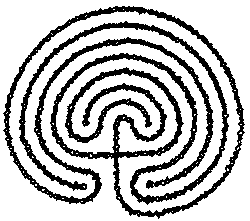This week’s question comes from a different direction: “I recently read about walking the sacred labyrinth. Someone told me labyrinths were New Age, but then I heard they were used in churches…. Are labyrinths Christian and is it appropriate for a Christian to walk on one?”
Before we get started, let’s define what a labyrinth is. Many people confuse labyrinths with mazes, and although the two have some common characteristics, they are fundamentally very different. A maze is mind puzzle. It has a variety of paths, twists and turns that lead nowhere, and the goal is to find your way in or to find your way out—or both.
A labyrinth, on the other hand, looks much like a maze in that it has twists and turns, but the similarity ends there. Labyrinths have only one path. They go in to the center and then you have to turn around and walk back out. There are no tricks or puzzles to figure out, only a winding path leading to the center. There are three “standard” designs of labyrinths—the seven circuit, eleven circuit, and twelve circuit (the number of concentric circular paths of the radius).
While it is true that many in the New Age movements have used/are using labyrinths, labyrinths themselves are anything but “new.” It seems that labyrinths have been around for over 4,000 years and have been used in many, if not most, major world religions on and off throughout the millennia. The earliest record we have of the labyrinth is from Greece—specifically, Crete. The Cretan labyrinth is considered the most classical of all the patterns and is a seven circuit path (see illustration below). The Cretan labyrinth was so popular in its culture that it was embossed on pottery and imprinted on coins.
But what was the labyrinth used for? Scholars are divided over the ancient use of labyrinths. The earliest labyrinths were carved into rocks, impressed on coins, and painted on pottery. There is no evidence they were used for anything more sacred than storytelling. Indeed, the Cretan labyrinth was developed as part of the legend of the minotaur (the center of the labyrinth was the minotaur’s lair). In about 1800 BCE, Egyptian King Amenenhet apparently built the first labyrinth large enough to be walked, although its purpose is obscure.
Clearly, however, the use of the labyrinth began to take on some sort of sacredness. Following the walkable labyrinths in Egypt, other large scale labyrinths began to pop up around Europe. Relatively ancient turf labyrinths have been discovered in England, Germany, and Scandinavia and some scholars believe they were used for agricultural and fertility rituals.
The Church apparently got into the act beginning in the fourth century. Laid into the floor in the basilica of Reparatus in Algeria is a Roman style labyrinth, a seven circuit labyrinth. Again, it’s exact use is uncertain, but by the Middle Ages when the Crusades to Jerusalem were raging, the Roman Church began to use labyrinths for a specific, sacred purpose.
In the Roman Church it became fashionable for Christians to make a vow to visit the holy city of Jerusalem sometime during their lives. However, when the Crusades made it unsafe and unwise to travel to Palestine, the Church felt compelled to develop an alternative way for pilgrims to keep their vows. And so labyrinths were constructed in the French Cathedrals of Chartres, Amiens, and Rheims. Pilgrims who could not travel to Jerusalem would travel to one of these cathedrals and walk, often on their knees, the labyrinth.
Today, labyrinths are used almost exclusively for enhancing the spiritual lives of those who choose to walk the path. Walkers travel a path that meanders back and forth, turning 180 degrees at the end of each circuit. Because there are no choices to make, once one has decided to enter the path, the mind is free to concentrate on the journey. Psychologists report that the repeated twists in the labyrinth stimulates both the left and right hemispheres of the brain, a phenomenon that walkers report brings a sense of balance and well-being to their journey.
Many use the path to enhance prayer and to meditation. Walkers travel the journey to the center contemplating their current situation, a problem, or a concern. In the center they may offer their concerns to God and then listen to what God might be offering. On the pathway out, walkers contemplate how they might incorporate what they’ve experienced into their lives.
As labyrinths become more prevalent and available in churches, their acceptance and use will rise dramatically. Certainly the labyrinth has a long history in the Church and can be incorporated as another tool available for those who seek a meditative presence with God.
And for those readers who may be interested, there
are several labyrinths available in the Metro Atlanta
Area, including one at the Holy Trinity Parish in
Decatur and another at the Cathedral of St. Philip
in Atlanta. Both are available and open to the
public.

Figure 1 Classic Cretan Labyrinth
